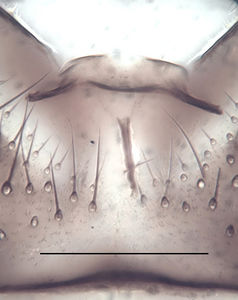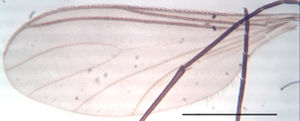Trichosiopsis paradisi
Ordo: Diptera
Familia: Sciaridae
Genus: Trichosiopsis
Name
Trichosiopsis paradisi unpublished
Type material
Holotype: ♂, 04.12.2017, sweep netting, leg. Heller, ZFMK-TIS-2605424 in ZFMK
Type locality
Morocco, Souss-Massa, Ida-Outanane, Paradise Valley
Barcoded material
| Stadium | Country | Province | Locality | Habitat | Method | Date | Collector | Collection Number | Collection | Latitude | Longitude | Elevation (m) |
|---|---|---|---|---|---|---|---|---|---|---|---|---|
| 1 ♂ (holotype) | Morocco | Souss-Massa | Ida-Outanane, Paradise Valley | sweep netting | 04.12.2017 | Kai Heller | ZFMK-TIS-2605424 | ZFMK | 30.5886 | -9.5250 | 331 |
Description (male)
Head. Eye bridge 4 rows of facets. Antenna unicolour. LW-index of 4th flagellomere 3.3–3.6; neck 0.38–0.48 × segment width; transition of basal part to neck pronounced. Colour of neck unicolour. Antennal setae shorter than segment width; of normal strength; dense; adjacent. Palpus darkened; of normal length; palpomeres 3. First palpomere of normal shape; with 3–4 setae; with only sparse sensilla. Second palpomere short and oval. Third palpomere as long as first. Thorax. Colour brown. Notum unicolour. Thoracic setae long and strong; black. Posterior pronotum setose. Postpronotal setae 1–3. Mesothoracic sclerites bare. Legs. Colour yellow-brown. Hind coxa darkened. Setae on front coxa darkened. Front tibial organ as patch of setae; dark; front tibial organ not bordered. Tibial setae on hind legs normal, shorter than tibial width. Tibial spurs of equal length. Claws untoothed. Wing. Wing slightly darkened; of normal shape. Wing membrane without macrotrichia. Wing venation weak, with faint stM. M-fork of normal shape. R1 ending at or slightly before base of m-fork; posterior veins with macrotrichia; stM mostly with macrotrichia, or with a few macrotrichia; CuA1 and CuA2 mostly with macrotrichia; bM bare; r-m with few setae; bM:r-M 0.7–0.8; st-Cu:bM 0.2–0.35; R1:R 0.3–1.6; c:w 0.65–0.75. Halter darkened; of normal length. Abdomen. Abdominal setae strong; dense; on tergites black; on sternites black, or brown. Hypopygium concolour with abdomen; LW-index 0.5–0.7. Base of gonocoxites with weak setae; gonocoxites narrowly separated; inner margin of gonocoxites typically U-shaped; inner membrane of hypopygium scarcely setose; ventral margin of gonocoxite with short setae. Gonostylus elongate; LW-index 2.05–2.32; Inner margin concave; apex with one obtuse angle. Apical tooth present; without internal structure; of medium strength; LW-Index 1.9–2.5. Awl-like setae normal; present beneath apical tooth, or beneath apical tooth numerous and reaching far beyond the tooth. Megasetae absent. Whiplash-hair absent. Tegmen 0.4–0.55 × longer than broad; rectangular with rounded edges; without special features; central process absent. Length of ejaculatory apodeme/hypopygium 20–26 %; base of ejaculatory apodeme present. Field with aedeagal teeth inconspicuous. Measurements. Body size 2.5–3 mm. Hind tibia 1.46–1.56 mm. Wing length 2.8–3.5 mm.
Diagnosis
Trichosiopsis paradisi is a medium-sized species, which belongs to the Trichosiopsis rejecta species group. The shape of the gonostylus reminds of Trichosiopsis coloniae, but the apical tooth is longer. The species is peculiar for the Tr. rejecta group by the very long antennae.
DNA Barcoding
The COI sequence is assigned to BIN BOLD:AEB1060 (n=1, K2P: 11%).
Etymology
lat. paradisus = paradise. The name refers to the collecting place “Paradise Valley”.
Discussion
The singular COI sequence (BIN) and the morphological distinctiveness of this species underlines the poorly studied and endangered species richness of North Africa and the Mediterranean Region.
Distribution
Morocco.
Images
|





